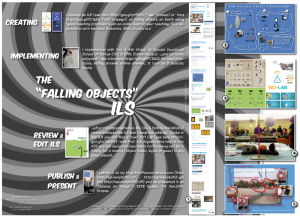Experimental (open) inquiry with low-cost materials, on the simultaneous freefall of two different bodies from the same height (for General & Special Education). For (**) EKFE Εgaleo’s 8th National Competition Experiments (context: Illuminating Science Education) – summary.
{for the Greek post click here}
GoLab Teachers’ Contest 2015 here.
To study the free fall many teachers have developed some very interestesting educational experimental setups and activities using ICT and robotic applications (e.g. Arduino), as the EKFE Thesprotia’s activity of and EKFE Preveza’s activity. Initially, our activity (as an idea – spring of 2013) also started with a more “complicated” device to “jam” of electromagnetism …BUT eventualy we choose a didactic proposal usin a “simple” device, to investigate whether two bodies arrive simultaneously or not in the ground, using simple low-cost materials through an open inquiry. You can see the experimental device in the following (blue) poster. For the implementation of thiw activity the use photo/video cameras and/or smartphone and/or and/or tablet and photo editing software and video is “required”.
We used the Graasp platform and the Global Online Science Labs for Inquiry Learning at School (Go–Lab), to build a multilingual, Inquiry Learning Space (ILS) course. Moreover, the virtual laboratory for Special Education & Educational / snowfall comes as evidence of teaching options (display, research or evaluation).
By ‘clicking’ on the ILS website ou have to insert a nickname. Ypu can write any nickname (e.g. kf, 1234, George, …) and by ‘clicking’ on Go! You gonna see the ILS entitled Falling Objects.
For “Falling Objects” ILS click here:
>>>>>> http://goo.gl/X4c4so <<<<<<
or here http://www.golabz.eu/spaces/falling-objects
Photos & Videos (‘click’ on the pictures below)
>> 2013
>> 2014a
>> 2014b
Bibliography is here
Acknowledgements (**)
The present proposal “took shape” during 2013-14 with a) the support of Sotiris Mandiliotis (Serres EKFE), Aik. Bezergiannidou (Consultant for Science Teachers), Konstantina Pilidou (Special Educational Consultant), b) the immediate acceptance of colleagues like Suzana Delic (Primary subject teacher & ICT teacher, Primary school Horvati, Zagreb, Croatia) and c) the enthusiastic participation of our students.
I would also like to thank Professor AA (Anjo) Anjewierden for the immidiate response to our call for the creation of an EDT with the parameters requested and Adrian Holzer for his continuum support on Graasp issues.
* * *
shortlink: http://wp.me/p3oRiZ-bY







